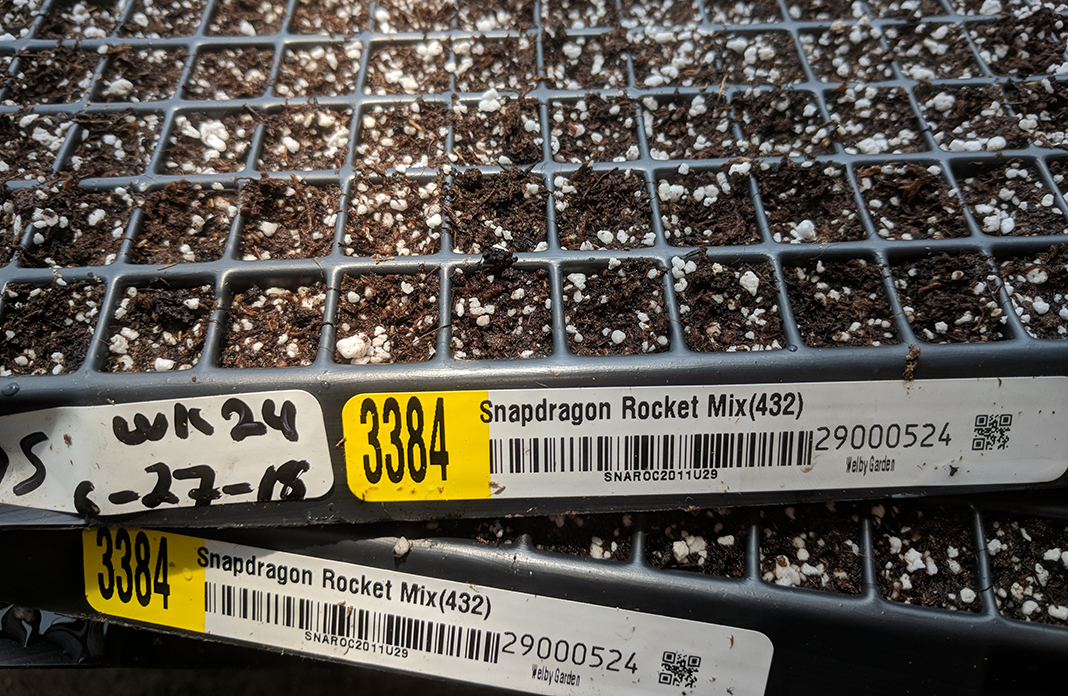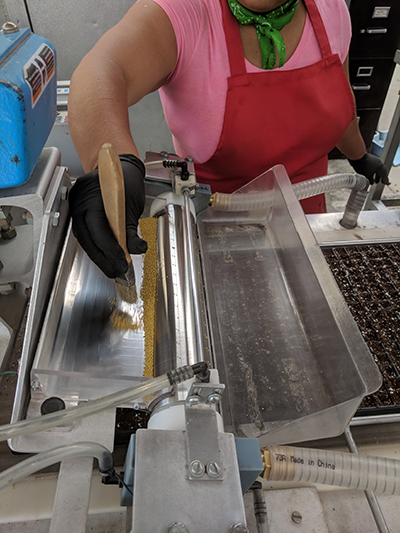Having a crystal ball to forecast how many seeds you need to produce enough plants to satisfy customer demand would be nice. Instead, successful greenhouse growers rely on good data and observations from past seasons. Whether using sophisticated custom software or simple spreadsheets, growers need to consider many factors to accurately calculate the timing and quantity of seed orders.
“The 30-second answer to how to calculate seed orders is to use software programmed to track when and how many seeds germinate. The program will automatically total up our need for seeds if we want to produce the same amount of plants in the future,” said Welby Gardens Production Manager Dan Gerace, CGG.
To determine the number of plants to produce over the next year, the Welby Gardens staff looks at historical sales and considers future trends. The sales history tells them what quantities of plants sold during different weeks, and trend analysis helps them forecast customer demand — whether it will remain the same, decrease, increase or even shift in timing.
“We have lots of different plantings of the same crops to make sure we always have fresh material. For example, if we are planning to grow 500 flats, we usually don’t plan for all 500 to be ready on one date. We do a few batches of them, starting during different weeks, hitting a peak of production and tailing off at some point in the season,” Gerace said.

Welby Gardens begins looking at each year’s sales numbers after June 30 when the spring selling season is over. The staff keeps track of how many plants of each variety were sold, and whether all flats sold well or lingered on the bench. Then, the company expands their look to a three-year sales history to spot sales trends. Based on those numbers, the company determines if it should produce more or less for the coming year. Trends can be manipulated a bit with targeted marketing of new or popular varieties and colors to enhance consumer interest, but real customer attitudes and preferences must also be taken into account.
“We need specifics from salespeople: What did customers really want? How much more? What color?” he explained. “We have to listen to customers and talk to customers, but we also have to look at our actual past sales to them, to understand whether they are likely to purchase less or more of different plants.”
Welby Gardens orders nearly 800 seed varieties each year. When planning for the number of seeds necessary to produce a desired number of plants, one of the challenges is to account for the seeds that don’t result in saleable plants. Several factors can lead to the plant numbers being fewer than the seed numbers.
Based on historical success, seed companies inform growers of the germination rates of their products. These rates can change season to season even with seeds from the same company.
 “With current seed technology, most companies won’t sell you seed unless it’s above a certain standard like a germination rate of 88 percent or better. If a seed has a rate worse than that, they may ask if you are still interested in purchasing,” he said. “Typically, we buy the most expensive pansy seed from companies innovating for uniformity. Then, we can plan on 90 percent of our pansies coming up.”
“With current seed technology, most companies won’t sell you seed unless it’s above a certain standard like a germination rate of 88 percent or better. If a seed has a rate worse than that, they may ask if you are still interested in purchasing,” he said. “Typically, we buy the most expensive pansy seed from companies innovating for uniformity. Then, we can plan on 90 percent of our pansies coming up.”
If a seed supplier indicates a variety has a 90 percent germination rate, then 10 percent of the seeds are expected not to grow plants. So, for example, if you want 1,000 plants, 1,000 seeds are not enough. An additional 10 percent will need to be ordered.
“The worst thing is to want 1,000 plants, buy 1,100 seeds, but come out with only 900 plants. If you don’t calculate what your actual useable plant percentages are, then you won’t have the plants to sell, and you are not going to make your sales goals,” he said.
Growers must also factor in how much seed and plant loss will result from variables within their own operations. Seed being eaten by mice, washed away from drips or by waterline breaks, and misses by seeding machines are a few circumstances that could result in lower plant production. Young plants breaking or otherwise not surviving are also a consideration in production calculations, which may require higher seed orders to compensate.
While under-ordering is probably the first concern, over-ordering seeds can also be a negative on the balance sheet. Leftover seed, purchased but not used in one season, may become old and not germinate well the next year. You lose money by having to throw away old seed or by not getting enough plants from them.
 “Most seed packets that consumers get have longer shelf lives than really high-tech seed that is pre-germinated or specialized for growers, which often expire after six months,” Gerace said. “You can go to any of our seed companies and ask about specific crops, and they will say to use them within a specific time. They have set expiration dates.”
“Most seed packets that consumers get have longer shelf lives than really high-tech seed that is pre-germinated or specialized for growers, which often expire after six months,” Gerace said. “You can go to any of our seed companies and ask about specific crops, and they will say to use them within a specific time. They have set expiration dates.”
Timing seed orders can be tricky if the goal is to get seeds just before planting, so they are not stored as long and are being used closer to the time when the plants will be purchased. Production staff familiar with planning crops can fairly easily look at what date that a finished crop is desired and work backward from that date to determine when seeds are needed for planting. To calculate the growing time, they consider many factors such as variety types and seasonal temperatures and sunlight, which can decrease or increase growing time.
“We’ve bounced around a little bit on when we order seeds, based on how suppliers supply. In the past, we used to buy all seed before the new year, and have it for five or six sowings, but some did not come in because the suppliers were still cleaning and processing them,” he said. “Then, we switched to a procedure where I basically bring seed in six weeks before each sowing. We have a big seed order for December that covers sowing for January, and then I order more seed in time for the next sowing and so on.”
With multiple seed orders over the season, however, Welby Gardens has experienced unexpected seed shortages when suppliers ship the whole first order, but cannot fulfill subsequent orders completely.
“In the past, they held seed on the shelf for us and didn’t sell to others, but that doesn’t always happen now,” he said. “If I could dedicate myself to looking at every purchase order that came back short or back ordered, I could make an adjustment to our production schedules or buy a different variety or color to hit our numbers. But, as a wholesaler, we are trying to meet our customers’ orders, and if we can’t supply them with the plants they want, when they want, that leads to dissatisfaction and lost sales on their end.”
Shortages can cause other issues as well, such as the necessity to print new tags and account for unused tags, which can be regulatory, labor and logistical headaches. Consequently, he is switching back to making the bulk of his seed orders in December.
“Planning is important and hopefully being informed of potential shortages such as crop failures at seed companies. You want to hear about that early so bigger companies don’t buy up all of the seed,” he concluded. “We use a broker network for growers so I don’t have to keep track and stay in constant contact with seed farmers. I call the seed company or broker who has direct contact with the farmers. If you have a really good representative at your broker, they can give you good information early. If you don’t have that link, then you have to be paying very close attention to what’s going on.”










